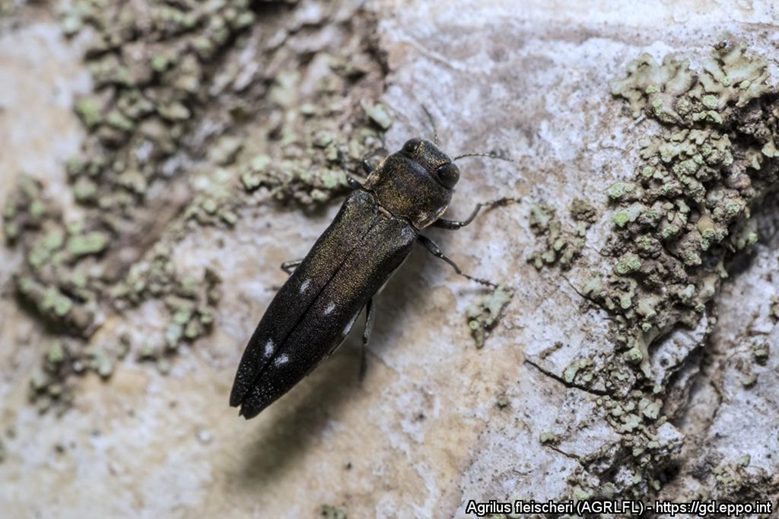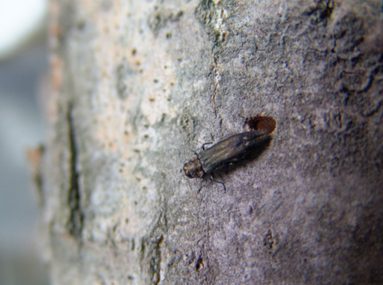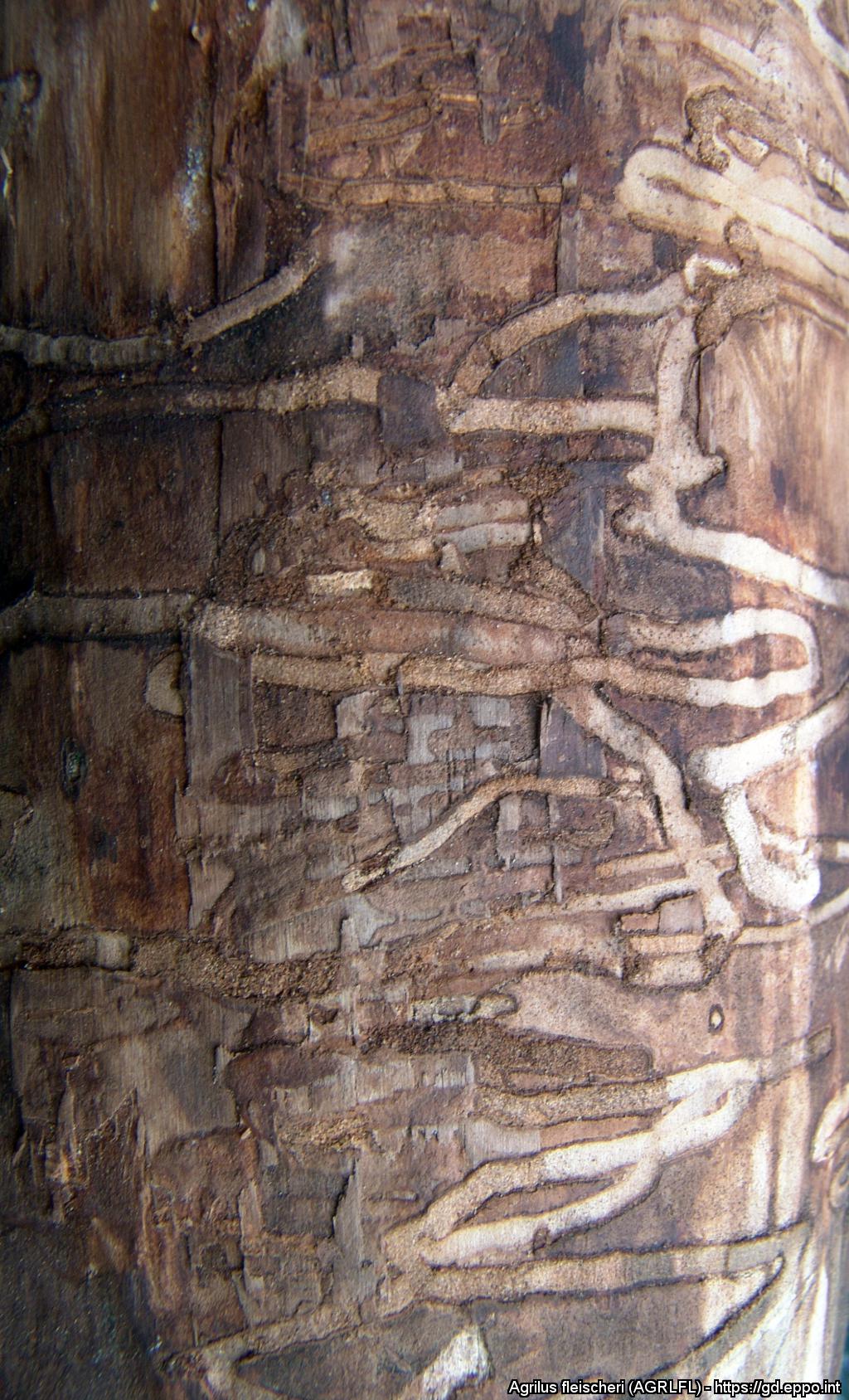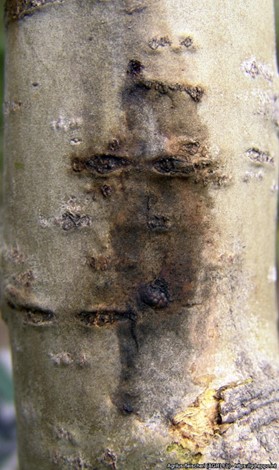Not present in UK
Notifiable – see ‘Report a sighting’ below
Scientific name – Agrilus fleischeri (A. fleischeri)

Agrilus fleischeri is an important pest of aspen and poplar (trees in the genus Populus). Willows (Salix spp.) have also been recorded as hosts of this pest, which is native to East-Asia.
There have been no reported discoveries of the pest in the United Kingdom (UK), but we remain vigilant for an accidental introduction. Suspected sightings must be notified immediately to the forestry authorities: see ‘Report a sighting’ below.
Distribution
A. fleischeri is native to East Asia, from Russia to China and as far west as Kazakhstan. It has not been reported outside its native range.
Susceptible species
In its native range, A. fleischeri has been found to infest Eurasian aspen (Populus tremula), Korean aspen (P. tremula var. davidiana), laurel-leaf poplar (P. laurifolia), Lombardy poplar (P. nigra var. italica) and to a lesser extent, willows (Salix spp).
Lombardy poplar, which is not native to A. fleischeri’s range, is more susceptible to the pest than native species. This should be considered if the insect were ever to become established in the UK, where it could be a threat to the rare native black poplar (P. nigra var. betulifolia) as well as damaging to the more widespread Eurasian aspen (P. tremula).
The Threat
A. fleischeri is a cambial-feeding (beneath the bark) pest with a preference for stressed trees, causing dieback and increased mortality.
A. fleischeri is a pest of species present in the UK, such as the Eurasian aspen (P. tremula). Since it infests a wide variety of poplars, aspens and willows in its native range, it is assumed that any tree of the genus Populus or Salix could be at risk. In addition, the pest seems to prefer certain species that are foreign to its native range, such as Lombardy poplar (P. nigra var. italica).
A. fleischeri could be damaging to the widespread willows (Salix spp.) present in the UK, though they are not its preferred host. The insect poses a much greater threat to the less common Eurasian aspen (P. tremula), and its preference for the Lombardy poplar (P. nigra var. italica) may indicate a heightened risk for the closely related subspecies, black poplar (P. nigra var. betulifolia), which is endangered in the UK.
Identification and symptoms
Adult A. fleischeri are dark brown to black in colour with two pairs of white spots on their elytra (wing cases). One pair of spots is at the centre of the closed elytra and the second pair is located towards the tip. The insects are typically between 7.3 and 12.3 mm long and 1.8 to 3.4 mm wide. Adult A. fleischeri beetles are very similar in appearance to the native A. ater, making casual distinction between the two species difficult.

Pictured above: Adult A. fleischeri with D-shaped exit hole. Photo credit: Mr. Zang Kai
Adults insects and signs of their feeding can be found on the leaf margins of their host species. They also leave D-shaped exit holes on the trunks of trees.

Pictured above: A. fleischeri larval feeding galleries. Photo credit: Mr. Zang Kai (Agrilus fleischeri (AGRLFL)[Photos]| EPPO Global Database)
The larvae produce characteristic serpentine galleries (above), which can be exposed when pieces of bark fall or are cut from damaged trees which have been infested for one or two years. Typical A. fleischeri galleries meander, bend sharply, and are packed with frass (the fine, brown, powdery refuse produced by the boring activity, and the excrement of the larvae).
Signs of infestation in hosts are yellow foliage, dying branches, dieback and mortality. The smooth pale bark of some aspens (ex: P. tremula var. davidiana) becomes dark brown and cracks vertically. This is not normally visible on species with rougher bark such as P. nigra var. italica.
Pictured below: Infested Populus davidiana, Liaoning province (China) Photo credit: Mr. Zang Kai (Agrilus fleischeri (AGRLFL)[Photos]| EPPO Global Database)

Report a sighting
If you believe you have observed A. fleischeri, or signs of its presence in one of the tree species listed above, you must report it immediately.
- Report suspected sightings in Great Britain to us with our TreeAlert online pest reporting tool.
- Report suspected sightings in Northern Ireland to the Irish forestry authorities using TreeCheck, the all-Ireland pest reporting tool.
Note that TreeAlert and TreeCheck both require clear, well lit digital photographs of the pest and/or symptoms of its presence.
Suspected sightings, especially sightings within the plant trade, can also be reported:
- in England or Wales – to the Plant Health & Seeds Inspectorate (PHSI) of the Animal and Plant Health Agency (APHA) on planthealth.info@apha.gov.uk; tel: 0300 1000 313;
- in Scotland – to the Scottish Government on hort.marketing@gov.scot; tel: 0131 244 8923; and
- in Northern Ireland – to the Department of Agriculture, Environment & Rural Affairs (DAERA) on planthealth@daera-ni.gov.uk; tel: 0300 200 7847.
If possible, catch any beetles you find and place them in secure containers such as sealed glass jars so that an inspector can collect them. The beetles are not harmful to people.
Life cycle
A. fleischeri has a one-to-two-year life cycle. Adults emerge from late May to mid-August, leaving D-shaped exit holes on trunks which are on average 3 mm in length and 2 mm in width. Adults survive on average for 34 days, feeding on the leaves of their host plants.
Females lay on average 218 eggs within bark cracks and crevices of poplars, aspen or willows. Larvae produce serpentine galleries under the bark, feeding on the cambium where they feed, and later go on to feed on the xylem (wood). Mature larvae create pupal chambers in the outer sapwood, where they pupate into adults.
Regulation
A. fleischeri is a quarantine pest for the United Kingdom, and is on the EPPO A1 list of quarantine pests with potential to cause extensive damage if introduced.
The UK Government website has details of the regulations governing the importation of:
See the UK Government website for guidance on the regulations designed to protect the UK from accidental introductions of plant pests.
Official Action
Action would be taken in the event of an interception of A. fleischeri in the UK, with the aim of eradicating the insect. The response to a confirmed interception would be likely to include the following actions.
- Establishment of a buffer zone around the infested tree or trees.
- A temporary ban on any felling, tree surgery, or pruning of trees and shrubs within the zone while a survey is carried out.
- A ban on movements of host plants and wood out of the zone. This would include plants from garden centres.
- A survey of all possible host trees within the buffer zone. The zone would be extended if necessary, outwards from any other trees found to be infested.
- Felling and chipping of infested trees and shrubs and, as a precaution, any nearby host trees. (Experience with Asian longhorn beetle has shown that neighbouring trees may be found to be infested only after they have been felled, when they can be more closely inspected than is possible when they are standing.).
- Annual re-surveys of the area for several years afterwards to check for any continuing presence.
